Most homeowners have some idea of the features they would like to have in their yards and how they want to use them, yet they are often unsure of their choices and how to put it all together in an appealing and functional design. A design theme can offer inspiration and guidance for making decisions about which features to include, appropriate materials, and spatial organization. Understanding how to use a theme for design guidance can be helpful for finding a theme that works for your yard. Themes can be identified and reproduced, which makes them useful for creating a visually pleasing and functional yard.
Design Themes
A landscape designed around a theme has identifiable characteristics, such as specific built features, distinguishing materials, a signature form, and recognizable spatial organization. Many themes are culturally historic and very well defined, such as traditional Italian or Japanese gardens (Figure 1). They have been used for centuries in a particular culture and are easily identified. Other themes are newer, less defined, and although they have identifiable characteristics, they tend to have several variations. For example, a minimalist garden, which is a simple design, can be different forms or types, including formal, informal, urban, tropical, or desert.
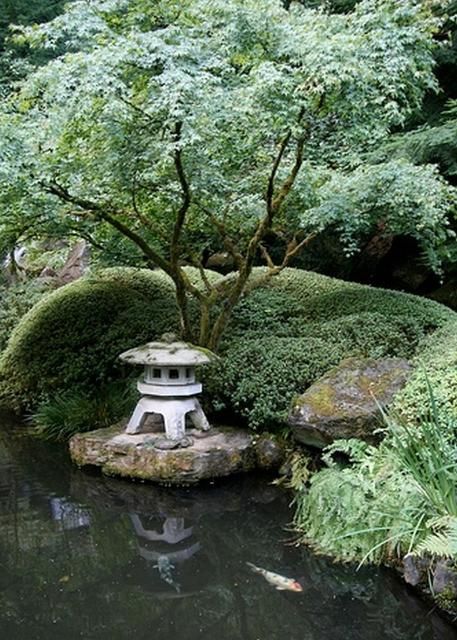
Credit: Center for Landscape Conservation and Ecology
Using a design theme is helpful because most of the decisions that must be made about the landscape are already made—they are inherent in the theme. A design theme can be based on a form (Figure 2), a style, a type of landscape, or a combination of any of the three. One important distinction is that all landscapes have a form because everything has form, but not all landscapes have an identifiable style or type. For example, many yards in today's suburban neighborhoods and gated communities are not considered a traditional style, but they have form in the ever-present foundation plant beds with curved lines and large lawns. American suburban yards have become so generic and identifiable that they could now be considered a landscape style—perhaps American classic? Landscape forms, styles, and types have different characteristics and functions, as described below.
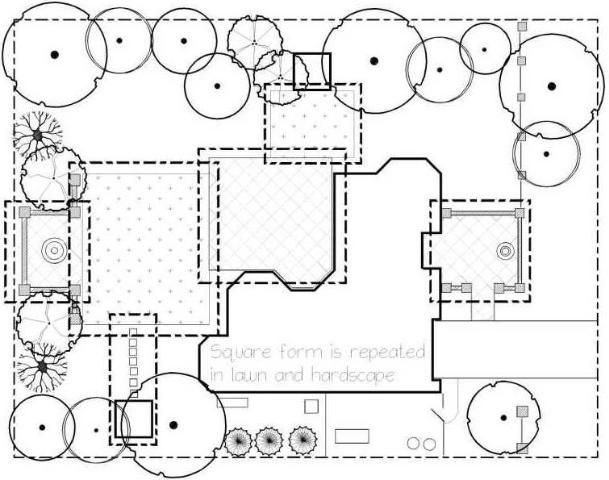
Credit: Gail Hansen
Landscape Forms
Design themes based on landscape forms are the easiest to recognize because they are characterized by a distinct form. Forms generally fall into two categories—geometric and naturalistic—and most gardens include both forms. Geometric forms are typically found in the hardscape, and they include rectangles (Figure 3), circles (Figure 4), and polygons (Figure 5). Naturalistic forms are most often found in the plant material. Geometric forms work well for repetition and organization in the garden. Squares can be segmented and arranged in grid patterns, circles can be segmented and used with lines to create arcs and tangents, and irregular polygons can be used to fit in odd-shaped spaces. Geometric forms are often considered to be formal. A number of design styles are associated with a particular form; for example, a garden with an Italian theme typically incorporates rectangular forms.
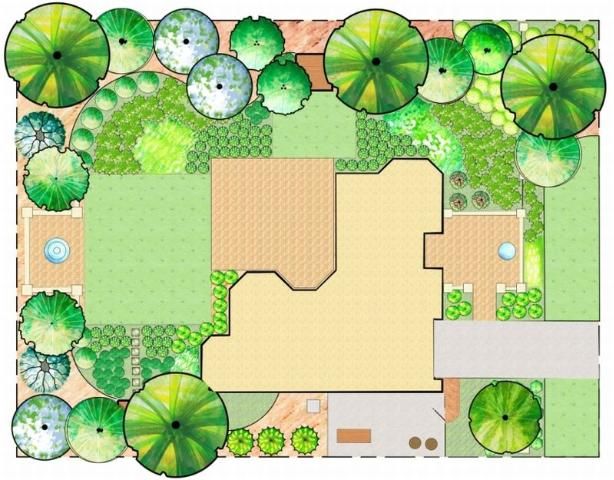
Credit: Gail Hansen
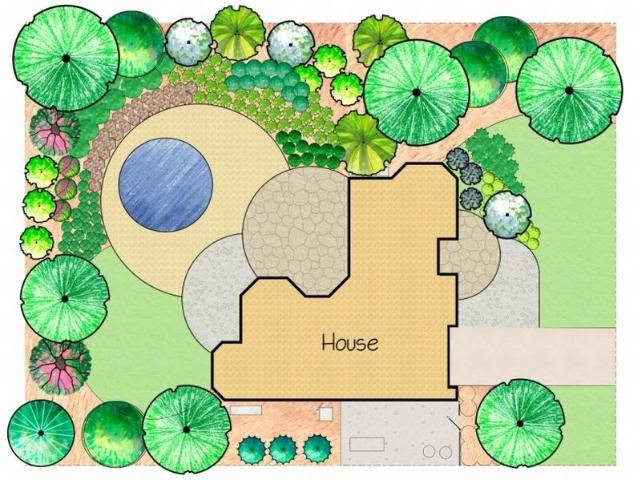
Credit: Gail Hansen
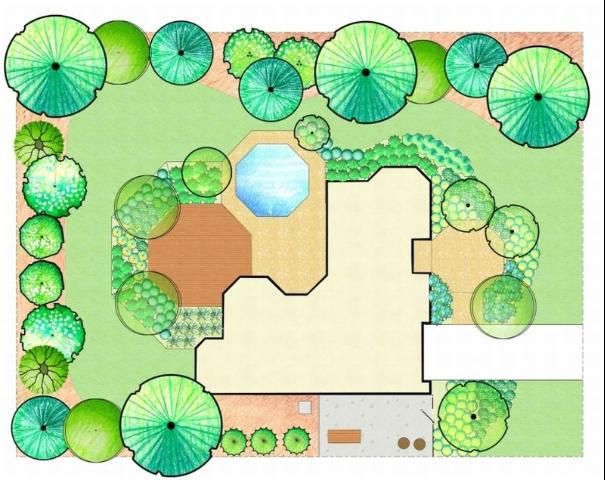
Credit: Gail Hansen
Naturalistic Forms
Naturalistic forms tend to be informal. As the name implies, these are forms that are found in nature and imitated or used in a more abstract manner in the design. The emphasis is typically on the arrangement of materials to appear natural and not the function, unless it is a re-created ecosystem, such as a restored wetland. Plants and land forms (creeks, rocks, hills, and valleys) have a variety of forms, including meandering lines, organic edges, and fragmented edges. Meandering lines are often used for plant bed edges and pathways, and organic and fragmented edges are used to make built features, such as dry creek beds and rock gardens, look more natural (Figure 6).
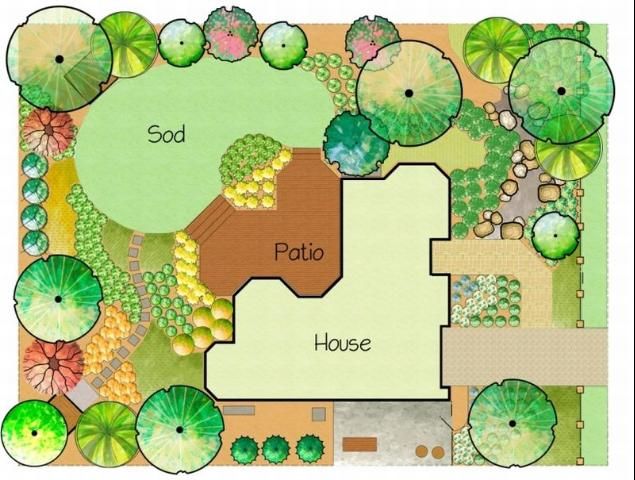
Credit: Gail Hansen
Landscape Styles
Landscape styles can be identified because they are based on a collection of distinctive features and materials with a recognizable organization and/or form. Examples of landscape or garden styles include cultural and historic gardens, such as Italian, English, Japanese, or Spanish colonial gardens. Other styles may be historic utilitarian gardens, such as cottage gardens, colonial kitchen gardens (Figure 7), or swept yards. Styles also include urban, contemporary, classic, or iconic designs that can be attributed to a particular designer, a certain design movement, or a design period. Examples include California midcentury modern and, more recently, minimalist modern, a style based on a collection of just one or two plants, such as a garden composed almost entirely of grasses, ferns, or palms.
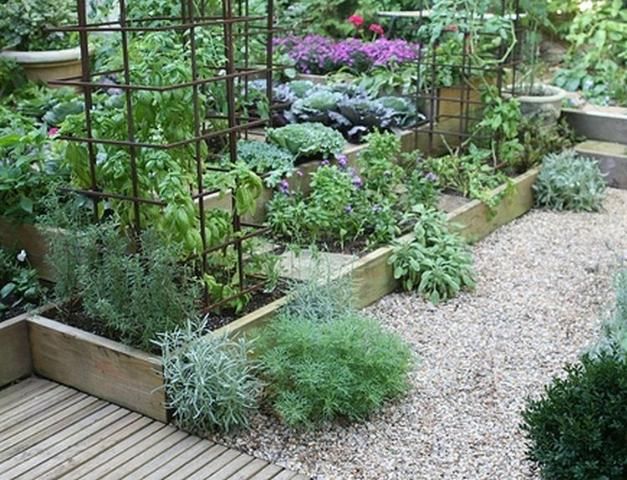
Credit: Center for Landscape Conservation and Ecology
Landscape Types
Landscape types are typically based on a type of ecosystem or plant material, or they have a particular type of function. Examples of landscapes based on ecosystems include desert, prairie, woodland (Figure 8), or coastal. They can be identified by a particular combination of plants common to those regional ecosystems. Landscape types sometimes mimic the organization of the plant materials as they are found in nature (naturalistic form), but they can also have a more structured (geometric form) layout. Gardens based on function include firewise design, which is a particular layout intended to protect a home from wildfires; dry gardens (or water-conserving gardens) that are composed entirely of drought-tolerant plants; or feng shui gardens designed to improve energy flow, based on the ancient Chinese philosophy of the same name.
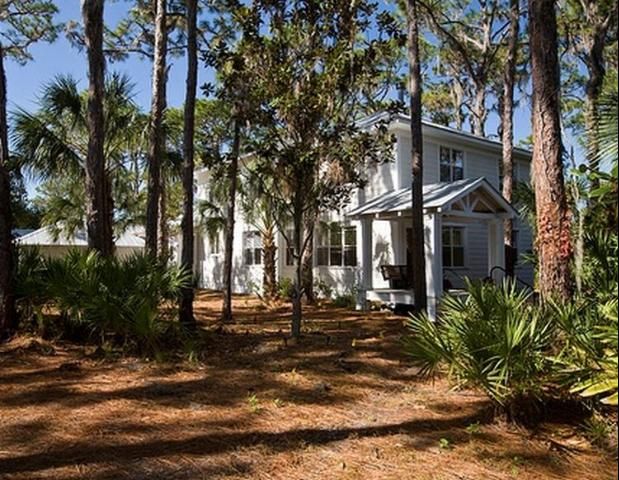
Credit: Center for Landscape Conservation and Ecology
Finding Design Theme Inspiration
There are several places to find design theme inspiration and examples. The best place to start is your own community. Once you find a landscape that appeals to you, study the features of the landscape and identify the most common form, whether naturalistic or geometric. Also look for specific built features and materials that would represent a particular style or type of landscape. Things to consider when looking for a design theme are detailed below.
Consider the region in which you live.
Study the natural ecosystems and native plants in your area for ideas. The combinations of plants could be replicated in your yard in different forms. You may also find a particular style of garden that has been historically used in your area. For example, areas of Mexican or Spanish influence, such as southern California and Florida, commonly have Spanish colonial gardens. The original cottage-style gardens, common in the Northeast, are now found in all areas of the country. The organization of the plants remains consistent, but the plant material reflects the region. There are tropical cottage gardens, seaside cottage gardens, and urban/contemporary cottage gardens.
Consider the architectural style of your house.
Some homes, especially historic or older homes, have an identifiable architectural style, and there are garden styles that are commonly associated with the style. The traditional bungalow is often associated with a cottage garden, the symmetry of the Italianate style matches the formal geometric style of an Italian garden, and a contemporary house can be complemented with a contemporary garden that either echoes the straight lines of the house or softens it with an ecodesign that mimics nature. Many homes today are no particular style, except for what one might call a "builder's special." They are often simple structures without much detail, which offers the opportunity to put more detail and personalization in the landscape.
Tour neighborhoods you like.
Look for a common or repeated style or form in the houses and yards. If the homes have a common style, such as Tudor, then many may have cottage gardens. Most people will find a variety of landscape designs in their neighborhoods, so the best option may be to find a house that is architecturally similar to yours with a yard you like and use it for inspiration. This way you will know exactly how the landscape style will look with your house.
Visit model homes with demonstration gardens.
A number of model homes have professionally designed landscapes that complement the house. Some communities have built energy-efficient homes for public tours that include sustainable landscapes with the latest technology in irrigation and hardscape. Sometimes the yards in entire communities have been designed by professionals, but it is usually best to visit these communities when they are newly built because the landscape often degrades over time from lack of care or simply from changes the homeowners make in the plant material.
Look in magazines and garden books.
Look particularly for images with homes that have the same architectural style as yours and note both the hardscape and the plant material. Try to imagine the design with your house. If you have design software for editing photographs, you may be able to scan images from magazines or books and cut and paste your home into the picture.
Consider forms that you find appealing.
Choosing a form theme may be as simple as selecting your favorite form and using it repeatedly in the design. For example, if you like the shape of circles, you can find ways to incorporate them into your design. The actual shape of your house may also help when choosing a form. Some houses have octagonal-shaped bay windows or curved walls that can be replicated in the hardscape or plant beds in the yard.
Consider plants you find appealing.
Some plants have a structure or form that is very appealing when planted in large sweeping masses, such as grasses or bamboo. These plants often have enough variety in different cultivars to create interest in the landscape, and a theme can be based on the use of one plant. A theme can also be based on one color. For example, a great variety of plants has yellow in the flower or foliage, and a very interesting, contemporary theme can be developed using only plants with yellow in them.
Consider the shape of the open spaces in your yard.
Open spaces are those areas between your property line and the house. The shape of these areas could inspire a design theme based on form. For example, the space between the fence and the back of the house may lend itself to a square form in the landscape or a series of circular forms.
Applying the Theme to the Design
Once you have identified a theme, decide which features to incorporate in your yard. You can use a few features to give a hint of the theme, or you can replicate the theme entirely. First, decide on the form to use in the hardscape and possibly in the shape of the planted areas. Next, arrange the forms in different layouts to try different concepts until you have a spatial organization that is functional and aesthetic. (Figures 1–4 show four different concepts for the same house and yard.) This is referred to as creating outdoor rooms, where different spaces in the yard—such as a patio, lawn area, garden, and play area—represent rooms. Once the spatial organization is finalized, the details of the design can be added.
The design theme may have a particular color or color combination associated with it, or you may need to choose a color theme. The color could be inspired by the plant material or ornamental features, such as pottery or sculptures. Materials must also be decided upon. For example, the theme may call for brick and wood for more traditional themes, or metal and cut stone for more contemporary themes. Built structures may include arbors, trellises, and garden houses, which could be "old fashioned" or modern in style. The types of plants are also important—a traditional theme may use plants found in historic gardens and old neighborhoods, while a contemporary theme might use new cultivars and plants with unusual shapes and colors. Other details include the ornaments and decorative elements, such as birdhouses, birdbaths, and lighting.
References
Reid, G. 1993. From concept to form in landscape design. New York: Van Nostrand Reinhold.
Scarfone, S. 2007. Professional planting design: An architectural and horticultural approach for creating mixed bed plantings. Hoboken, NJ: John Wiley & Sons.
Thomas, H., and S. Wooster. 2008. The complete planting design course: Plans and styles for every garden. London: Mitchell Beazley, Octopus Publishing Group.